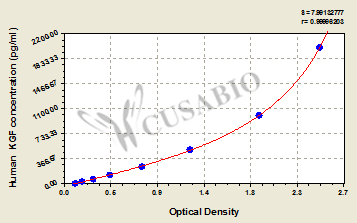The human keratinocyte growth factor (KGF) ELISA Kit is engineered for accurate measurement of human KGF levels from samples including serum, plasma, or tissue homogenates. It uses the Sandwich-ELISA mechanism in combination with the enzyme-substrate chromogenic reaction to measure the KGF content in the sample. The color intensity is positively correlated with KGF content in the sample. This kit has been validated against standards of sensitivity, specificity, precision, linearity, recovery, and lot-to-lot consistency.
KGF, also called FGF7, is a mesenchyme-specific heparin-binding growth factor that stimulates cell proliferation, differentiation, migration, and vascular angiogenesis. FGF7 is required for the development of the kidney, thymus, and hippocampus. It exerts its functions by binding to high-affinity receptor FGFR2IIIb. FGF7 is also involved in the healing process, which makes it an agent for reducing inflammation and injury. Several studies have shown that FGF7 is expressed in many types of cancer, including prostatic, breast, colorectal, and lung, and is associated with the proliferation and regulation of tumor cells.




